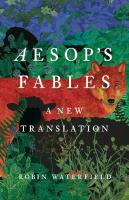
Basic Books (2024) p/b £25 (ISBN 9781541604841)
Of the 700 Aesop fables that survive (not including the many variants), W. has selected 400 that strike him as ‘the most familiar, most entertaining, most profound, most historically informative, and most surprising (perhaps unexpectedly political or sexual)’. His aim, in which he has been wholly successful, is to ‘combine close fidelity to the original texts [occasionally emended] with readable, modern English’.
W.’s introduction is admirably brief and to the point. Fables were an ancient genre, familiar in Mesopotamia c. 2500 BC and India. We first hear of Aesop from Herodotus who described him as a slave living on Samos c. 550 BC, who was freed and killed by Delphians for insulting them. Whether true or not, everything else about him was drawn from what his oeuvre suggests he ‘must’ have been like (typical of ancient biography) and all fables were subsequently assigned to him (cf. medical texts and Hippocrates). Demetrius from Phalerum made the first collection in the 4th C BC; the later collections best known to us are those versified by Phaedrus in Latin (1st C AD) and Babrius in Greek a century later. Down the millennia further versions were made, often for educational purposes, and all those surviving were finally collected by B.E. Perry in 1952.
Aesop’s fables are, as the ancient Greek rhetorician Theon saw, ‘fictitious stories picturing a truth’, in a world where truth is black and white. Since human beings are a devious lot, the lessons of the fables are best presented by non-human types, popularly believed to behave in specific ways—the brave lion, tricky fox, feeble mouse, and so on, though there are also talking bushes and trees as well as men and gods. The lessons thus conveyed are clean, decisive and instantly applicable and offer the speaker the chance to criticize human behaviour in a light-hearted way, always useful when you are a slave.
They also take a wide range of forms: some are simply jokes, some ironic, some allegorical, some philosophical and so on. Lessons conveyed are often rather pessimistic but also consolatory, urging people to know their place and stick to it, and usually ending with a summarising ‘moral’. Interestingly, Quintilian was quite wrong in suggesting that fables appealed only to ‘country yokels and the uneducated’. As W. shows, fables were found useful in all sorts of different contexts e.g. by politicians (against other politicians), speechwriters, philosophers, lyric and comic poets, at symposia and other congenial gatherings.
Here are examples of some of the less well-known fables among many of the old favourites in W.’s highly enjoyable selection:
THE OXEN AND THE AXLE
Some oxen were pulling a waggon when the axle creaked. The oxen turned their heads and said to it ‘Hey, what’s this? We’re doing all the hard work and you’re complaining?’
Likewise, there are some people who pretend to be exhausted when it’s others who’ve been working.
THE HYENA COUPLE
They say that hyenas change their gender year by year, from male to female and back again. Once a male hyena forced a female to have anal sex, and she said ‘Go ahead, my dear! Don’t stop! But just remember that before long, you’ll be the one at the receiving end.’
This fable could well be told to a current holder of political office by the one who’s going to succeed him.
THE MONKEY’S SONS
A monkey in labour gives birth to two sons, but once they’re born the mother treats them completely differently. One of them she cuddles to her breast so fiercely that she smothers it; she literally loves it to death. The other, however, she pushes away as an expendable waste of space. So he retreats to some deserted spot—and lives.
This is how people often behave as well. You should always keep your distance from such people and not befriend them.
THE CRAB AND HIS MOTHER [PJ comments: and her mobile phone?]
‘Don’t walk aslant’ the mother crab said to her son. ‘Don’t drag your body sideways over the wet shingle!’ But he said, ‘Dear mother and teacher, first move in a straight line yourself and then I’ll see how to do it.’
THE BRIDE OF WAR
The gods were getting married and each of them had been allotted a partner. The last of the gods to come and draw a lot was War, and as there was only one lot remaining, he gained Arrogance as his wife. And apparently he fell madly in love with her, for he follows her wherever she goes.
And so may Arrogance never find a foothold in the nations or cities of the world and be welcomed by the voting public, because War will be right behind her.
With its fine introduction, wide-ranging selection of fables helpfully grouped by the actors (‘Insects, Invertebrates and Arachnids’, ‘Birds’, ‘Fox fables’, etc.), notes, reading recommendations and concordance matching W.’s translations to Perry’s edition, this is an Aesop which will surely enjoy very wide appeal, among laymen and classicists alike.
Peter Jones
